NCERT Solutions Class 8 Mathematics
Chapter – 7 (Cubes and Cube Roots)
The NCERT Solutions in English Language for Class 8 Mathematics Chapter – 7 Cubes and Cube Roots Exercise 7.2 has been provided here to help the students in solving the questions from this exercise.
Chapter 7: Cubes and Cube Roots
Exercise – 7.2
1. Find the cube root of each of the following numbers by the prime factorisation method.
(i) 64 (ii) 512 (iii) 10648
(iv) 27000 (v) 15625 (vi) 13824
(vii) 110592 (viii) 46656 (ix) 175616
(x) 91125
Solution –
(i) 64
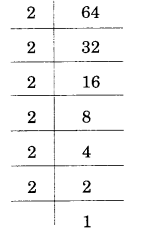
64 = 2×2×2×2×2×2
= (2×2×2) × (2×2×2)
= (2×2)3
= 43
Hence, = 4.
(ii) 512
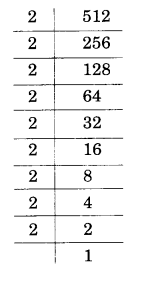
512 = 2×2×2×2×2×2×2×2×2
= (2×2×2) × (2×2×2) × (2×2×2)
= (2×2×2)3
= 83
Hence, = 8.
(iii) 10648
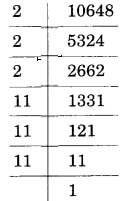
10648 = 2×2×2×11×11×11
= (2×2×2)×(11×11×11)
= (2 ×11)3
= 223
Hence, = 22.
(iv) 27000
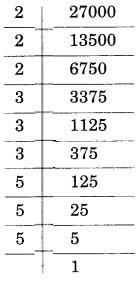
27000 = 2×2×2×3×3×3×3×5×5×5
= (2×2×2)×(3×3×3)×(5×5×5)
= (2×3×5)3
= 303
Hence, = 30.
(v) 15625
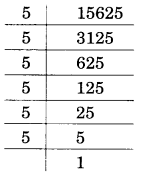
15625 = 5×5×5×5×5×5
= (5×5×5) × (5×5×5)
= (5×5)3
= 253
Hence, = 25.
(vi) 13824
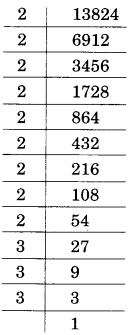
13824 = 2×2×2×2×2×2×2×2×2×3×3×3
= (2×2×2)×(2×2×2)×(2×2×2)×(3×3×3)
= (2×2× 2×3)3
= 243
Hence, = 24.
(vii) 110592
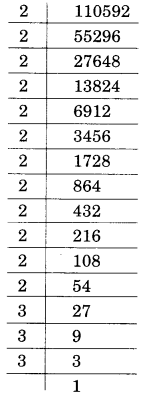
110592 = 2×2×2×2×2×2×2×2×2×2×2×2×3×3×3
= (2×2×2)×(2×2×2)×(2×2×2)×(2×2×2)×(3×3×3)
= (2×2×2×2×3)3
= 483
Hence, = 48.
(viii) 46656
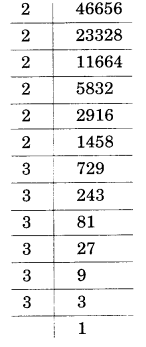
46656 = 2×2×2×2×2×2×3×3×3×3×3×3
= (2×2×2)×(2×2×2)×(3×3×3)×(3×3×3)
= (2×2×3×3)3
= 363
Hence, = 36.
(ix) 175616
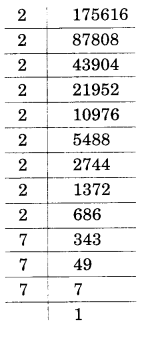
175616 = 2×2×2×2×2×2×2×2×2×7×7×7
= (2×2×2)×(2×2×2)×(2×2×2)×(7×7×7)
= (2×2×2×7)3
= 563
Hence, = 56
(x) 91125
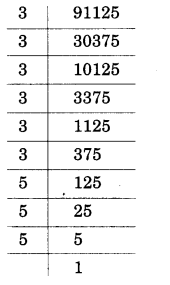
91125 = 3×3×3×3×3×3×3×5×5×5
= (3×3×3)×(3×3×3)×(5×5×5)
= (3×3×5)3
= 453
Hence, = 45.
2. State true or false.
(i) Cube of any odd number is even,
(ii) A perfect cube does not end with two zeros.
(iii) If square of a number ends with 5, then its cube ends with 25.
(iv) There is no perfect cube which ends with 8.
(v) The cube of a two digit number may be a three digit number.
(vi) The cube of a two digit number may have seven or more digits.
(vii) The cube of a single digit number may be a single digit number.
Solution –
(i) Cube of any odd number is even, (False)
(ii) A perfect cube does not end with two zeros. (True)
(iii) If square of a number ends with 5, then its cube ends with 25. (False)
(iv) There is no perfect cube which ends with 8. (False)
(v) The cube of a two digit number may be a three digit number. (False)
(vi) The cube of a two digit number may have seven or more digits. (False)
(vii) The cube of a single digit number may be a single digit number. (True)
3. You are told that 1,331 is a perfect cube. Can you guess without factorisation what its cube root is? Similarly, guess the cube roots of 4913, 12167, and 32768.
Solution –
Cube root of 1331
The given number is 1331.
Step 1. Form groups of three starting from the rightmost digit of 1331. 1331
In this case, one group i.e., 331 has three digits whereas 1 has only 1 digit.
Step 2. Take 331.
The digit 1 is at one’s place. We take the one’s place of the required cube root as 1.
Step 3. Take the other group, i.e., 1. Cube of 1 is 1.
Take 1 as ten’s place of the cube root of 1331.
Thus, =11
(ii) Cube root of 4913
The given number is 4913.
Step 1. Form groups of three starting from the rightmost digit of 4913.
In this case one group, i.e., 913 has three digits whereas 4 has only one digit.
Step 2. Take 913.
The digit 3 is at its one’s place. We take the one’s place of the required cube root as 7.
Step 3. Take the other group, i.e., 4. Cube of 1 is 1 and cube of 2 is 8. 4 lies between 1 and 8.
The smaller number among 1 and 2 is 1.
The one’s place of 1 is 1 itself. Take 1 as ten’s place of the cube root of 4913.
Thus, = 17
(iii) Cube root of 12167
The given number is 12167.
Step 1. Form groups of three starting from the rightmost digit of 12167.
12 167. In this case, one group, i. e., 167 has three digits whereas 12 has only two digits.
Step 2. Take 167.
The digit 7 is at its one’s place. We take the one’s place of the required cube root as 3.
Step 3. Take the other group, i.e., 12. Cube of 2 is 8 and cube of 3 is 27. 12 lies between 8 and 27. The smaller among 2 and 3 is 2.
The one’s place of 2 is 2 itself. Take 2 as ten’s place of the cube root of 12167.
Thus, = 23.
(iv)
Cube root of 32768
The given number is 32768.
Step 1. Form groups of three starting from the rightmost digit of 32768.
32 768. In this case one group,
i. e., 768 has three digits whereas 32 has only two digits.
Step 2. Take 768.
The digit 8 is at its one’s place. We take the one’s place of the required cube root as 2.
Step 3. Take the other group, i.e., 32.
Cube of 3 is 27 and cube of 4 is 64.
32 lies between 27 and 64.
The smaller number between 3 and 4 is 3.
The ones place of 3 is 3 itself. Take 3 as ten’s place of the cube root of 32768.
Thus, = 32.

